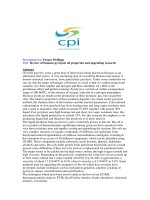The review of biomass pyrolysis oil properties and upgrading research
Bạn đang xem bản rút gọn của tài liệu. Xem và tải ngay bản đầy đủ của tài liệu tại đây (31.02 KB, 2 trang )
Presentation by: Fergus Melligan
Title: Review of biomass pyrolysis oil properties and upgrading research
Abstract
Over the past few years a great deal of interest has being placed on biomass as an
alternative fuel source. A very promising area of converting biomass into energy is
thermo-chemical conversion, more particularly pyrolysis. Under some conditions we
can say that the major advantages of biomass as a fuel is that it is carbon neutral and
contains very little sulphur and nitrogen and thus contribute very little to the
greenhouse effect and global warming. Pyrolysis is carried out within a temperature
range of 300-600
o
C, in the absence of oxygen, typically in a nitrogen atmosphere.
Biomass pyrolysis results in the production of three products: gas, bio-oil and bio-
char. The relative proportion of these products depends very much on the pyrolysis
method, the characteristics of the biomass and the reaction parameters. Conventional
carbonization or slow pyrolysis has slow heating rates and long vapor residence time
and is used to maximize char yields at around 35-40% together with around 30%
liquid. Fast pyrolysis uses high heating rate and short, hot vapor residence time, this
maximizes the liquid production to around 75%. For this research the emphasis is on
producing liquid fuel and therefore fast pyrolysis is of more interest.
The liquid produced from pyrolysis is more commonly known as bio-oil. Bio-oil is
not a product of thermodynamic equilibrium during pyrolysis but is produced with
very short residence time and rapidly cooling and quenching the reaction. Bio-oils are
very complex mixtures of organic compounds of different size molecules from
depolymerisation fragmentation of cellulose, hemicelluloses and lignin, resulting in
the formation of an excess of 50 different compounds, which can be identified using
GC/MS. These compounds include carboxylic acids, ketones, phenols, aldehydes,
alcohols and esters. Bio-oils differ greatly from petroleum based fuels and as a result
present some difficulties if they are to be used as a replacement for petroleum fuels.
The major issues to be tackled are the high water content, the high oxygen content and
high viscosity. Depending on the pyrloysis conditions the crude bio-oil can contain up
to 30% water, (diesel has a water content of 0.05% [3]) 35-40% oxygen and has a
viscosity of about 13.2(@40
o
C in CsT), (diesel viscosity is 4.5 @40
o
C in CsT). Some
methods used for upgrading the properties of bio-oil which have recently been
developed, include techniques such as hydrodeoxygenation, catalytic cracking of
pyrolysis vapour, emulsification and esterification.
The techniques which have been used to analyse the bio-oil are GC/MS,
thermogravamitric analysis, FTIR, Karl Fischer titration, bomb calorimeter, elemental
analysis, viscometer.
About The Presenter
Fergus holds an honours degree in Industrial Chemistry from the University of
Limerick and is currently pursuing a PhD in the University. His supervisors are Prof
Michael Hayes, Dr JJ Leahy and Dr Witold Kwapinski.
His PhD work involves studies of pyrolysis and second generation biorefining for the
processing of carbohydrate waste materials and lignocellulose biomass to produce
bio-oil. Another useful product which he investigates is the residual bio-char which
has value in soil amendment.
He will also investigate the most efficient procedures (time, temperature and pressure)
for the bio-refining process of wastes and biomass. An analysis of the products
formed as the parameters are varied will lead to an awareness of the transformation
mechanisms involved.
DATE: 27
th
Nov 09
TIME: 10- 11am
VENUE: POD meeting room FG 028









